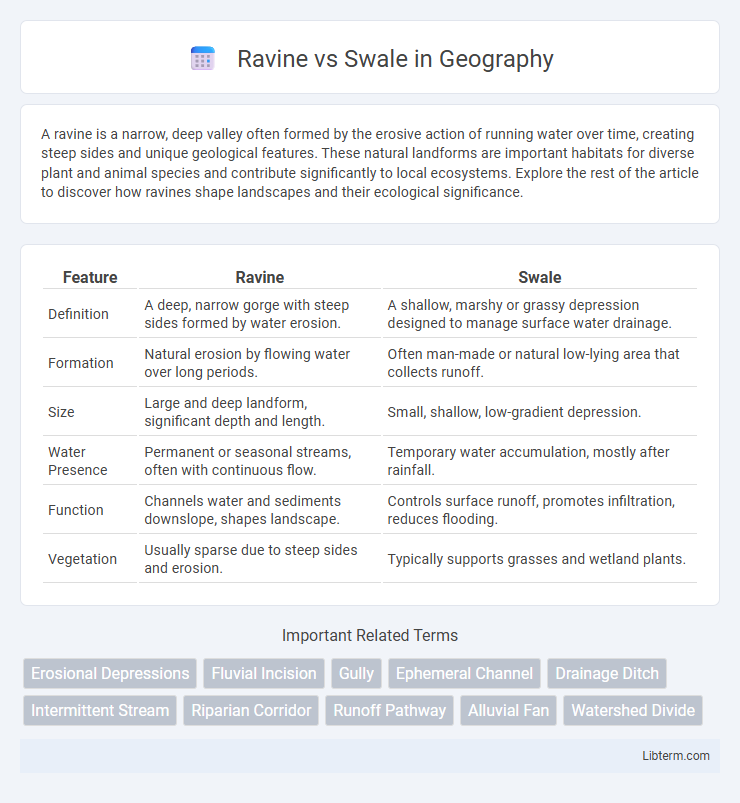A ravine is a narrow, deep valley often formed by the erosive action of running water over time, creating steep sides and unique geological features. These natural landforms are important habitats for diverse plant and animal species and contribute significantly to local ecosystems. Explore the rest of the article to discover how ravines shape landscapes and their ecological significance.
Table of Comparison
| Feature | Ravine | Swale |
|---|---|---|
| Definition | A deep, narrow gorge with steep sides formed by water erosion. | A shallow, marshy or grassy depression designed to manage surface water drainage. |
| Formation | Natural erosion by flowing water over long periods. | Often man-made or natural low-lying area that collects runoff. |
| Size | Large and deep landform, significant depth and length. | Small, shallow, low-gradient depression. |
| Water Presence | Permanent or seasonal streams, often with continuous flow. | Temporary water accumulation, mostly after rainfall. |
| Function | Channels water and sediments downslope, shapes landscape. | Controls surface runoff, promotes infiltration, reduces flooding. |
| Vegetation | Usually sparse due to steep sides and erosion. | Typically supports grasses and wetland plants. |
Understanding Ravines and Swales: Key Differences
Ravines are steep-sided valleys formed by water erosion, characterized by deep cuts and often flowing streams, while swales are shallow, gently sloping depressions designed to manage surface water runoff. Ravines serve as natural drainage paths in hilly terrain, contributing to soil and water conservation, whereas swales function primarily in landscaping and urban planning to direct water, reduce flooding, and enhance groundwater recharge. Understanding the distinct formation, purpose, and physical features of ravines and swales is essential for effective land management and environmental planning.
Geological Formation of Ravines vs. Swales
Ravines are steep, narrow valleys carved primarily by the erosive action of running water over long geological periods, often found in areas with resistant rock strata and significant gradient. Swales are shallow, elongated depressions formed mainly through soil subsidence or minor erosional processes in flat or gently sloping terrains, frequently serving as natural drainage channels. The geological formation of ravines involves intensive downcutting and mass wasting, while swales develop through subtle sediment deposition and water flow patterns in low-energy environments.
Hydrological Functions: Water Flow in Ravines and Swales
Ravines act as natural channels that rapidly convey surface water and runoff, often leading to concentrated flow and potential erosion. Swales function as engineered or natural shallow depressions designed to slow down water flow, promoting infiltration and groundwater recharge. Together, these landforms manage stormwater by balancing fast conveyance in ravines with water retention and filtration in swales.
Ecological Importance of Ravines and Swales
Ravines act as natural corridors for wildlife, supporting biodiversity by providing habitats and facilitating species movement. Swales contribute to ecological health by managing stormwater runoff, reducing erosion, and promoting groundwater recharge. Both landforms play crucial roles in sustaining local ecosystems and enhancing soil and water quality.
Erosion Patterns: Ravine vs. Swale
Ravines exhibit intense erosion patterns characterized by steep, narrow channels where water rapidly cuts through soil and rock, leading to significant sediment displacement. Swales show gentler erosion with shallow, broad depressions that promote slow water infiltration and minimal soil loss. The contrasting erosion dynamics make ravines prone to land degradation, while swales function as natural water retention and soil stabilization features.
Vegetation: Plant Life in Ravines and Swales
Ravines host dense, moisture-loving vegetation such as ferns, mosses, and hardwood trees, thriving in the shaded, nutrient-rich soils created by steep slopes and water runoff. Swales support a mix of hydrophilic plants like sedges, rushes, and wetland grasses adapted to periodic flooding and saturated soils in their gently sloping channels. The contrasting plant communities in ravines and swales play crucial roles in soil stabilization, water filtration, and maintaining local biodiversity.
Land Use and Human Impact
Ravines are steep, narrow valleys primarily formed by fast-flowing water erosion, often limiting agricultural use due to unstable slopes and soil erosion risks. Swales are shallow, gently sloping channels designed or naturally occurring to manage stormwater runoff, promoting groundwater recharge and reducing surface runoff in urban and agricultural landscapes. Human impact on ravines includes increased erosion and habitat disruption from construction, while swales are intentionally integrated into land use planning to enhance water management and mitigate flood risks.
Engineering Applications: Swales vs. Ravines
Swales are engineered landscape features designed for efficient stormwater management, directing runoff through shallow, vegetated channels that promote infiltration and reduce erosion. Ravines are natural landforms characterized by steep, narrow valleys shaped by persistent water flow, often requiring stabilization measures in engineering projects to prevent landslides and soil loss. Engineers prioritize swales for urban drainage systems due to their controlled design and multifunctional benefits, whereas ravines often present challenges in slope stabilization and flood risk management.
Flood Management: Role of Swales and Ravines
Swales and ravines play crucial roles in flood management by directing and controlling water flow to prevent flooding. Swales, shallow, vegetated channels, facilitate the slow infiltration and conveyance of stormwater, reducing runoff velocity and promoting groundwater recharge. Ravines, deeper natural landforms, act as major drainage pathways, channeling larger volumes of water away from developed areas and minimizing flood risks.
Choosing Between Ravine and Swale Solutions
Choosing between ravine and swale solutions depends on the specific landscape and drainage requirements of the area. Ravines, characterized by their steep slopes and deeper channels, are ideal for managing large volumes of stormwater runoff and preventing soil erosion in hilly terrains. Swales, shallow and gently sloping, efficiently capture and infiltrate surface water in flat or urban environments, promoting groundwater recharge and reducing flooding risk.
Ravine Infographic

 libterm.com
libterm.com